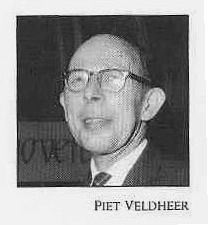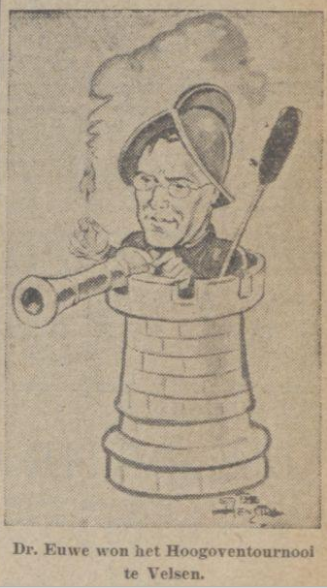In the very beginning the “Blast Furnace Chess Tournament” was better known simply as the “New Years Chess Tournament” (Nieuwjaarstournooi using the 1940’s Dutch spelling, or Nieuwjaarstoernooi using modern spelling). It started very simply, as a round robin between four players, with one round Saturday evening, then church Sunday morning, one round Sunday afternoon, a joint meal in the evening, and the final round Sunday night. The Dutchman, Piet Veldheer, was involved as an organizer and tournament director very early on, if not even from the beginning. His is a name to remember, as it is almost synonymous with the tournament itself.
 (I previously mistakenly had a picture of Piet Zwart here, another important figure in the history of Hoogovens. I’ll repost his picture when I do the extend the treatment below to all of Hoogovens’ history.)
(I previously mistakenly had a picture of Piet Zwart here, another important figure in the history of Hoogovens. I’ll repost his picture when I do the extend the treatment below to all of Hoogovens’ history.)
But there are many excellent histories of this famous tournament, and so I won’t continue with this rather meager one. You can find a little more here:
http://www.endgame.nl/wijk.htm
and, if you speak Dutch, here:
http://www.tatasteelchess.com/history/articles
And here is a site with some nice pictures of all the tournament books coming from all the years of play at this tournament.
http://www.kwabc.org/archive/Homepage-UK/Corus_Wijk3.htm
Now with that minimum introduction I come to my main point. Which is that all the one-page summaries of the tournament are lacking the kind of detail I would like to see. Most just list the year and winner. Not a bad idea, but let’s see if we can improve upon that.
Here is a hopefully improved summary of the tournament for the years 1938-1945. The Netherlands were occupied by Germany in May 1940, so several of the tournament years were under Nazi rule. In fact, the war was tragic for at least two of the players involved with the tournament, including a tournament winner from these years. But that is a subject for another post…
-------------------------------------------------------------------------------------------------------------------------------------------------- Year Index N FMT Start End Span Winner(s) Notes/Sources -------------------------------------------------------------------------------------------------------------------------------------------------- 1938 1st 4 RR-3 01-15 01-16 2/2 Sat->Sun 1-2 Bakker/Van Dijk (2.5/3) (van Reek - R1 Sat, R2/3 Sun) 1939 2nd 4 RR-3 01-21 01-22 2/2 Sat->Sun 1 Cortlever (3/3), 2 Van Steenis (2/3) (Piet Veldheer TD toernooi-voorzitter) 1940 3rd 4 RR-3 01-20 01-21 2/2 Sat->Sun 1 Euwe (3/3), 2 Van Steenis (2/3) (Di Felice only*/Euwe plays) 1941 4th 4 RR-3 01-11 01-12 2/2 Sat->Sun 1 Wijnans (2.5/3), 2 Cortlever (2/3) (Di Felice only*, NED occupied) 1942 5th 6 RR-5 01-01 01-04 4/4 Thu->Sun 1 Euwe (4.5/5), 2 Cortlever (3.5/4) (NED occupied) 1943 6th 8 RR-7 01-11 01-17 7/7 Mon->Sun 1 Van den Hoek (5.5/7), 2-3 Wijnans, Koomen (5/7) (NED occupied) 1944 7th 8 RR-7 01-03 01-09 7/7 Mon->Sun 1 Van Scheltinga (5/7), 2 Koomen (4.5/7) (NED occupied) 1945 -- (not played) --------------------------------------------------------------------------------------------------------------------------------------------------
I’m still a little unsure of the presentation, and so I don’t feel bad about leaving some of my working note in the above. The first N, or rather the third column, is the number of players. FMT is the format of the tournament, RR-<N> for round robin, and <N> stands for number of rounds. In some years in the 1990’s they experimented with a knock-out/swiss format. I think the experiment failed since they ultimately returned to the round-robin format. Then comes the start/finish dates, which can include non-playing days, for example, opening ceremony, and the famous “pea-soup” dinner on the last day. The <N/N> numbers just after the end day represent the “number of days with play”/”number of days of the tournament”. Note, that the number of days with play can be smaller than the number of rounds if more than one round is held on a given day. I also include the scores of the two top finishers in order to show how close the competition was.
I don’t know if Veldheer was involved in the 1938 tournament as an organizer, although I think he was by 1939. The tournament grew out of a chess club formed by workers at the steel plant. In fact, the first tournament was held at their clubhouse. Euwe’s participation in the third year was a tremendous boost.
As for the data in the table, I used contemporaneous sources to determine the dates for many of the years, utilizing the fabulous Delpher Kranten system provided by National Library of the Netherlands. You can find it here:
http://www.kb.nl/en/news/news-archive-2010/one-million-pages-of-dutch-historical-newspapers-online
Just look for the Delpher link.
Reading newspaper accounts from an occupied country, and knowing the fate of some of the players at the very moment their life is being celebrated, is a sad thing. I will write more on this later, and also show the complete pre-Corus (aka the Hoogovens tournament) table in the near future.
